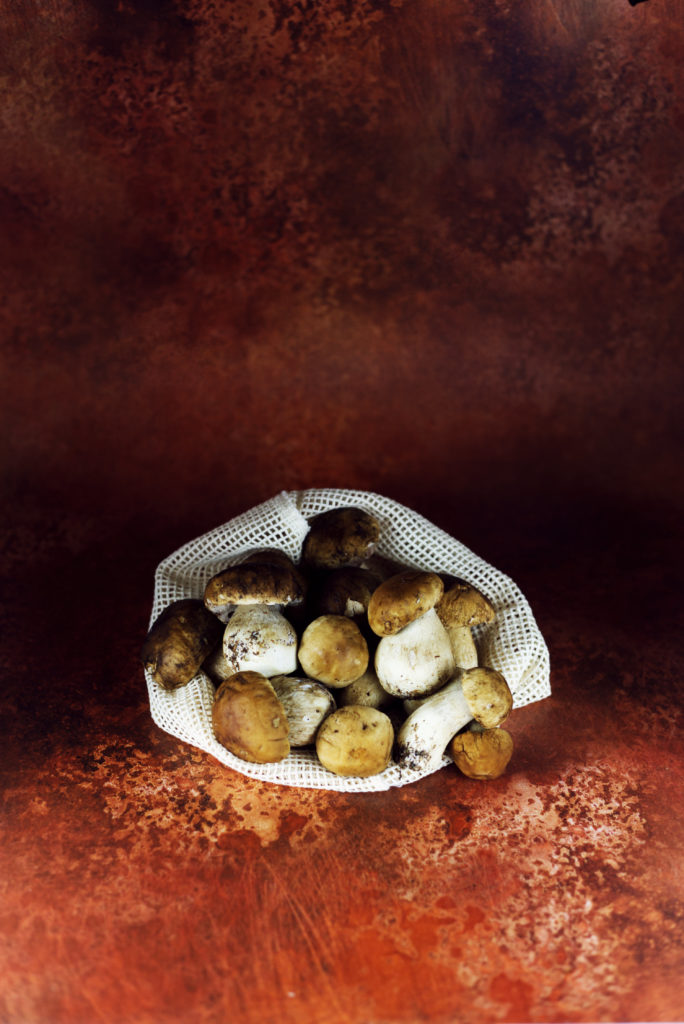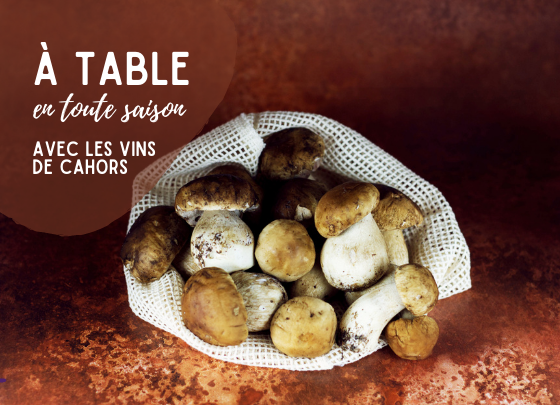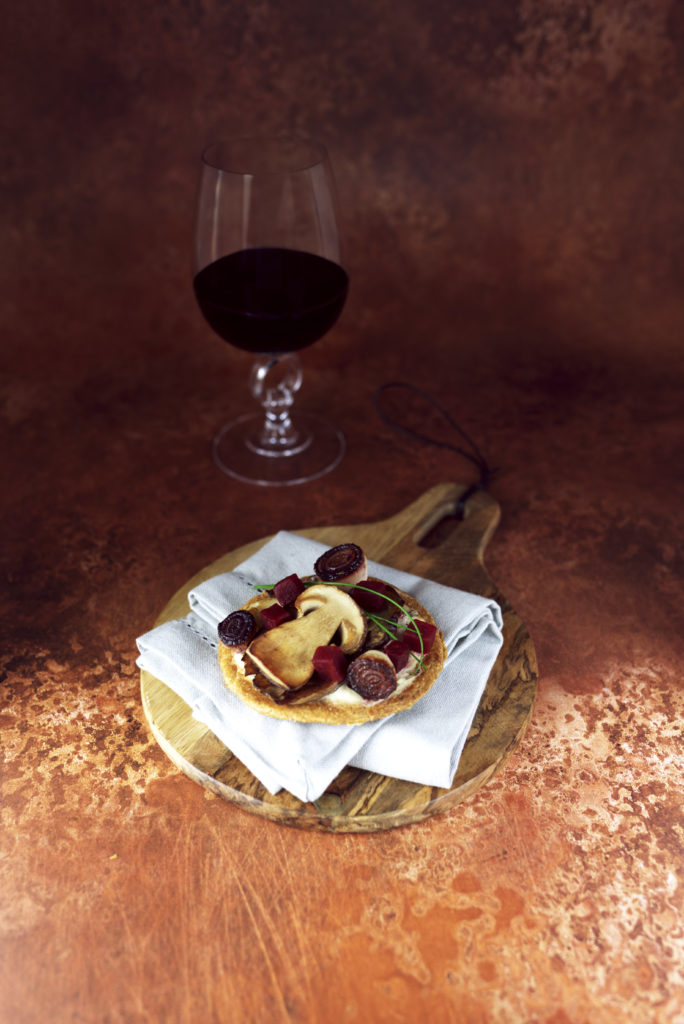𝐖𝐡𝐲 𝐢𝐬 𝐂𝐚𝐡𝐨𝐫𝐬 𝐰𝐢𝐧𝐞 𝐚 𝐩𝐞𝐫𝐟𝐞𝐜𝐭 𝐦𝐚𝐭𝐜𝐡 𝐰𝐢𝐭𝐡 𝐦𝐮𝐬𝐡𝐫𝐨𝐨𝐦 𝐫𝐞𝐜𝐢𝐩𝐞𝐬 ?

It’s autumn
It’s autumn and all Malbec grapes have been harvested in the region around Cahors. The grape juice of the new vintage has finished its alcoholic fermentation and has been turned into wine, and nature is now unfolding its final autumn spectacle right before our eyes: leaves of all colors and shapes flying in the wind, cold November rain, and the scent of humidity and earthiness are leading us into winter’s cocooning season.
One of the typical flavors of this season can be found within the fascinating spectrum of mushrooms whose earthy underwood aromas rise from the humid soils as we take our autumn walks. Harvesting mushrooms by hand in the forest is the privilege of knowledgeable connoisseurs and adventurers; however, more risk-averse souls can find many seasonal varieties at farmers’ markets.
The kings of the mushrooms
Mushrooms come in many shades of brown with slightly different tastes, but porcini mushrooms, also called cèpes, are the kings of the culinary world, and their majestic size and characteristically rounded brown hats overshadow most other edible mushrooms. Unlike button mushrooms, which can be found in most supermarkets, porcini are difficult to cultivate; these fungi depend on distinctive symbiotic connections with living trees, and thrive best in oak, chestnut, or pine tree forests, where they produce their edible fruit bodies in late summer and autumn. The abundantly wooded regions of France – in particular, in the southwest, including the region around Cahors – meet the criteria for porcini to develop; thus they have become an ingredient in many local specialties of the southwest.
Aromatic intensity and a chewy texture make porcini stand out from other mushrooms, whose textures are usually more fragile, and whose aromas are often more delicate. Porcini have a generous and sturdy bite and a unique flavor that ranges somewhere between hazelnut nuttiness, warm earthiness, soft creaminess, and umami heartiness.
Although the porcini seasons are relatively short, the harvest can be very meager or plentiful depending on the season’s weather, and porcini can be widely found as a dried ingredient in supermarket aisles, sliced or powdered. You can easily substitute fresh porcini with dried slices or chunks by simply soaking them in warm water or broth, but make sure to keep the delicious soaking water and use it in a soup, sauce, or risotto, to add depth and complexity.
Keep it simple
Carefully cleaned with a dry kitchen towel or a special mushroom brush, and most importantly, never rinsed under water, fresh porcini bring tons of flavor to any dish. Thinly sliced into a carpaccio, the freshest porcini present their delicate, mellow creaminess and supple earthiness, but pan-seared at a medium-high temperature, they reveal their full bandwidth and aromatic power, adding a delicate smoky dimension and the nuance of toasted nut aromas.
Pan-seared in butter with no more than a hint of garlic and a sprig of thyme or rosemary, porcini are a delicacy in themselves, to be savored on their own, or on a crunchy slice of grilled pain de campagne slathered with fresh butter. But they are also great for further preparations in soups, sauces, stews, risottos, pasta dishes, or even pâté.
To appreciate the porcini’s natural greatness, keep the seasoning as uncomplicated as possible, using sea salt, freshly cracked pepper, olive oil or butter, and fresh herbs; and pair it with simple yet high-quality ingredients that stand up to the mushroom king’s nobility – along with a bottle of Cahors, of course.
How to pair Cahors wine with porcini mushrooms?
Depending on your dish’s intensity and the other main ingredients, you can choose from the wide range of traditional Cahors styles that have undergone oak aging in barrels or wooden casks. Wines with shorter oak aging periods discreetly bring subtle spice and fruity abundance to your pairing, while wines with longer oak aging add more structure, underwood, spice, and depth.
For more inspiration, we are presenting two porcini recipes that will certainly impress your wine-loving invitees: an easy to make Tarte aux Cèpes that can be prepared in advance and served as an amuse-bouche or starter, and Purple Tagliatelle with Porcini and Beef, a super versatile dish for any weekday night or special occasion that requires a soul-warming treat.
Tarte aux Cèpes (Porcini Tart) Recipe
Serve cold or warm as an aperitif or starter
Ingredients for 4 portions:
- 100 g fresh pearl onions (or small red onions)
- 4 tbsp unsalted butter
- 200 ml red wine
- 2 tsp red wine vinegar
- 3–4 sprigs of thyme
- 1 pinch of sugar
- 1 portion puff pastry dough
- 400 g fresh porcini (or other fresh mushrooms)
- 2 garlic cloves
- 4 tbsp olive oil
- 1 glass of pickled beetroot in small cubes
- 100 g full-fat crème fraîche
- Sea salt and pepper
Steps to Make It :
- Peel the pearl onions and cut them into halves (or thick slices if you use regular red onions). Melt 2 tbsp butter in a saucepan over medium heat, then add the onions into the pan. Let sizzle very gently for 3–4 minutes, eventually turning down the heat. Turn the onions once with a spoon or spatula, and wait another 3–4 minutes until they become translucent.
- Add the red wine and red wine vinegar to the saucepan, along with the thyme sprigs, a pinch of sugar, a pinch of salt, and some pepper to taste. Cook on low heat until the liquid has fully reduced and the onions are cooked all the way through. If needed, add a few more spoonfuls of red wine or water to prolong the cooking time until the onions are ready. Once cooked, remove the thyme and set the onions aside.
- Heat the oven to 200°C (or 175°C fan) and line a baking tray with a sheet of parchment paper. Using a glass with a thin rim or a big round cookie cutter, cut out four circles of puff pastry dough and place them onto the parchment paper (you can also cut squares with a knife, or other forms if desired). Cover with another layer of parchment paper, then place a second baking tray on top to avoid the puff pastry rising too high (or use other flat-bottomed and oven-safe cooking ware – for example, a Dutch oven or oven-proof pan). Bake for 20 minutes. Once the puff pastry is browned and crispy, peel off the parchment paper and let the circles cool on a rack.
- Remove the earth and any dirty bits from the porcini and their stems by gently rubbing with a dry cloth or paper towels, or use a special mushroom brush. Especially crusty parts can be easily cleaned by scraping with a sharp knife. Once cleaned, cut the porcini into big, generous chunks.
- Using a large knife, slightly crush the unpeeled garlic cloves. Melt 2 tbsp butter in a heavy saucepan over a medium-high temperature, then add 2 tbsp olive oil and unpeeled garlic cloves. Let the garlic infuse for a few seconds, then add a handful of porcini. Allow them to sauté and sizzle until they are golden brown underneath before you start moving the pan. Turn them once and wait again. When all sides are golden brown, place them on a sheet of kitchen paper to remove the excess fat. Proceed with the next batch by starting to melt some more butter and adding more oil, then add the remaining mushrooms.
Garnish the individual puff pastry portions by covering with a thin layer of crème fraîche, sprinkling some sea salt and freshly cracked pepper to your taste, and arranging the onions, porcini, and beetroot cubes on top.
Wine recommendation:
Pick a Cahors that has been aged in oak for 12 to 18 months, which will add both supple tannins and delicate spice to the tart, all the while keeping a touch of fruitiness.
© Stefanie Köhler, Gouttes & goûts









